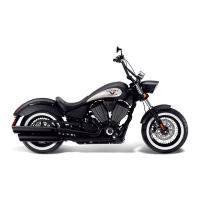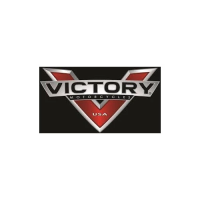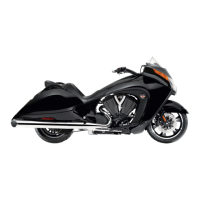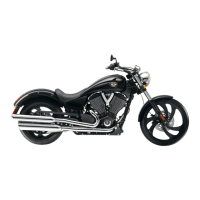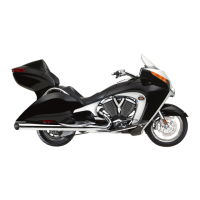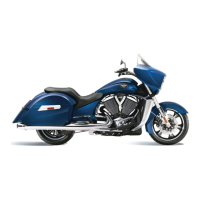Do you have a question about the Victory High-Ball and is the answer not in the manual?
Explains the purpose and importance of the owner's manual for safe riding and maintenance.
Defines signal words like WARNING, CAUTION, and NOTICE used for hazard communication.
Covers essential practices for safe motorcycle operation, including rider education and manual study.
Details when to reduce speed and how to use front and rear brakes effectively for maximum stopping power.
Provides guidance on preventing loss of control, including sidestand, curves, and towing.
Guidelines for safely carrying a passenger, including weight limits and passenger positioning.
Recommends essential protective gear for riders to minimize injury risk and enhance comfort.
Explains GVWR, load capacity, and guidelines for carrying cargo safely.
Specific instructions for operating with saddlebags, including speed limits and weight distribution.
Instructions for parking safely on firm, level surfaces and avoiding hazards.
Discusses how modifications can void warranty and affect safety and legality.
Provides instructions on how to properly secure the motorcycle using a truck or trailer.
Provides guidelines for selecting and installing accessories to maintain stability and handling.
Covers hazards associated with gasoline and exhaust fumes, including warnings and precautions.
Highlights the importance of pre-ride inspections and refers to detailed procedures.
States compliance with European and Canadian directives regarding EMI.
Illustrates the locations of various safety and information labels on the motorcycle.
Identifies and lists controls located in the handlebar area of the motorcycle.
Illustrates and lists major components visible from the left side of the motorcycle.
Illustrates and lists major components visible from the right side of the motorcycle.
Lists important identification numbers and their locations on the motorcycle.
Describes the functions of the Engine Off, Engine On/All Lights On, and Parking Lights On positions.
Details the speedometer and the various indicator lamps and their meanings.
Explains the functionality and modes of the multi-function display.
Lists available modes for the multi-function display and how to reset them.
Explains how to change display units between standard (miles) and metric (kilometers).
Describes the odometer and trip odometers, including how to reset them.
Explains the tachometer display and how gear position is indicated.
Provides step-by-step instructions for setting the motorcycle's clock.
Details accessory modes like fuel economy, trip hours, average speed, DC voltage, and air temperature.
Explains error messages and their meanings, advising to consult dealer for diagnosis.
Describes how to retrieve and interpret engine error codes displayed on the instrument cluster.
Explains the 'LO OIL' warning and the required actions to take.
Explains clutch, mode button, hazard, lighting, horn, and turn signal controls.
Details engine stop/run, starter, throttle, and front brake controls.
Explains how to shift gears using the gear shift pedal for lower and higher gears.
Details how to apply the rear brake for effective and safe stopping.
Explains the sidestand interlock switch and the procedure for operating the sidestand.
Provides instructions on how to adjust the motorcycle's mirrors for optimal visibility.
Details the procedure for opening and closing the fuel cap.
Explains how to remove side covers and how to operate the steering lock for security.
Emphasizes the necessity of pre-ride inspections to prevent component failure and ensure rider safety.
Details inspection procedures for electrical items like lamps, signals, horn, and indicators.
Provides instructions for checking the engine oil level using the dipstick.
Explains how to check the fuel level and notes the low fuel indicator.
Details inspection of fuel hoses and connections for leaks or damage.
Covers checking tire pressure, condition, and tread depth for safe operation.
Ensures cargo restraints are securely fastened to prevent cargo shifting.
Details checking the front brake lever, reach, and fluid level.
Details checking the rear brake pedal and its gap adjustment.
Covers rear brake fluid, lines, pads, and throttle operation checks.
Explains checking clutch lever and throttle freeplay for proper operation.
Covers inspecting suspension, steering, and drive belt for condition and tension.
Details inspecting the sidestand and chassis fasteners for proper function and security.
Provides guidelines for the initial 500 miles (800 km) break-in period for optimal engine performance.
Details the procedure for starting the motorcycle engine, including interlock systems.
Explains the function of the tilt sensor in stopping the engine if the motorcycle tips.
Covers safe refueling practices, recommended fuel, and the correct fuel tank fill height.
Provides instructions for priming the fuel system if the motorcycle runs out of fuel.
Details recommended shift points for upshifting and downshifting based on speed.
Explains the step-by-step process for shifting gears, including clutch and throttle coordination.
Explains how to accelerate the motorcycle smoothly and safely, avoiding abrupt movements.
Details safe braking techniques, emphasizing gradual application and stopping distance.
Provides the correct procedure for stopping the motorcycle engine and key.
Instructions for parking on level, sloped, or soft surfaces to ensure stability.
Highlights the importance of initial maintenance at 500 miles for optimal engine performance.
Refers to the VICTORY Service Manual for major repairs requiring specialized tools and skills.
Covers routine inspections, lubrication, adjustments, and replacements at specified intervals.
Emphasizes performing a road test after service to ensure safety and proper component function.
Provides a detailed table of maintenance tasks and intervals based on odometer reading.
Identifies the universal tool and its uses for servicing specific motorcycle components.
Provides a step-by-step guide for changing the engine oil and filter.
Explains the importance of checking engine compression for wear and condition.
Details the procedure for replacing the air filter element for optimal engine breathing.
Covers inspecting the drive belt for cracks, broken teeth, or fraying.
Provides specifications for drive belt deflection based on model and mileage.
Illustrates common types of drive belt wear and indicates when replacement is needed.
Details the step-by-step process for measuring drive belt deflection using a tension gauge.
Explains how to adjust the drive belt tension and wheel alignment.
Provides instructions for cleaning the drive belt and sprocket teeth for optimal life.
Details how to inspect rear wheel alignment using stamped marks.
Explains the procedure for adjusting rear wheel alignment.
Covers inspecting and measuring rear shock preload for optimal handling and safety.
Provides ride height specifications for various VICTORY motorcycle models.
Details the step-by-step process for adjusting rear shock preload.
Covers inspecting the swing arm and rear axle for movement and proper function.
Details inspecting the front forks for oil leaks, damage, and smooth operation.
Covers inspecting steering head bearings, front axle, and wheel bearings.
Details inspection of fuel hoses, crankcase ventilation, and fuel filters.
Provides step-by-step instructions for removing the motorcycle's fuel tank.
Details the procedure for reinstalling the motorcycle's fuel tank.
Explains how to measure and adjust throttle freeplay for smooth operation.
Details lubrication intervals and procedures for throttle cables.
Explains how to adjust clutch lever freeplay for proper engagement.
Details lubrication for the clutch lever and pivot screw.
Details lubrication for the clutch cable ends.
Explains how to adjust the gear shift pedal height and linkage.
Details checking the front brake fluid level, condition, and reservoir.
Details checking the rear brake fluid level, condition, and reservoir.
Details lubricating the brake lever pivot pin and housing.
Covers inspection of brake lines and pads for wear and leaks.
Details inspecting brake discs for damage and wear to minimum thickness.
Covers tire replacement guidelines and checking tire pressure.
Details inspecting tire sidewalls, tread, and wear bars for damage.
Covers inspecting wheel spokes for looseness, bends, or missing spokes.
Details inspecting wheels for cracks or damage.
Covers inspecting the exhaust system for leaks and tightening fasteners.
Provides specifications for spark plug type, gap, and torque.
Details how to inspect, clean, gap, and replace spark plugs.
Provides instructions for removing the seat on HAMMER S models.
Provides instructions for installing the seat on HAMMER S models.
Provides instructions for removing the seat on JACKPOT models.
Provides instructions for installing the seat on JACKPOT models.
Provides instructions for removing the seat on JUDGE/BOARDWALK models.
Provides instructions for installing the seat on JUDGE/BOARDWALK models.
Provides instructions for removing the seat on VEGAS/HIGH-BALL models.
Provides instructions for installing the seat on VEGAS/HIGH-BALL models.
Explains how to adjust handlebar position and the safety implications.
Details how to inspect headlight aim against specifications.
Explains the procedure for adjusting headlight aim vertically and horizontally.
Provides instructions for replacing a headlight lamp.
Details how to lubricate the sidestand for smooth operation.
Provides instructions for cleaning matte finish paint, avoiding abrasive products.
Details cleaning and care for suede paint finishes, noting it cannot be buffed.
Recommends VICTORY brand cleaning and polishing products for motorcycle care.
Details pre-wash steps, including cooling exhaust and checking caps.
Details the conventional bucket wash method using VICTORY Bike Wash Concentrate.
Describes the quick spray-rinse method for cleaning the motorcycle.
Recommends Spray & Wipe Instant Detailer for quick cleaning and polishing.
Provides instructions for cleaning and protecting polished aluminum components.
Details the standard method for polishing paint and chrome using VICTORY Polish.
Describes using Liquid Spray Wax for durable, high-gloss shine and protection.
Provides instructions for conditioning leather, rubber, and vinyl to protect and restore appearance.
Guidelines for selecting a dry, well-ventilated storage location.
Instructions for cleaning and protecting the motorcycle before storing.
Details adding fuel stabilizer to the tank for long-term storage.
Explains changing engine oil to prevent internal corrosion during storage.
Covers checking and adjusting tire pressure for storage.
Details cleaning, charging, and storing the battery properly.
Recommends using covers and taking measures against rodents.
Provides steps for removing the motorcycle from storage and preparing it for riding.
Details the one-year limited warranty covering defects in material or workmanship.
Explains the process for completing warranty registration with the dealer.
Lists exclusions from warranty coverage, such as accidental damage and normal wear.
Outlines limitations on implied warranties and remedies available to the owner.
Explains the procedure for obtaining warranty service from a VICTORY dealer.
Provides dimensions, weight, capacities, engine, chassis, drive system, and electrical specs.
Provides dimensions, weight, capacities, engine, chassis, drive system, and electrical specs.
Compares specifications across VEGAS 8-BALL, HIGH-BALL, JUDGE, and BOARDWALK models.
Details fuel/oil recommendations and locations for VIN, engine ID, and key numbers.
A table to log service performed, comments, mileage, date, and performer.
Explains the purpose and importance of the owner's manual for safe riding and maintenance.
Defines signal words like WARNING, CAUTION, and NOTICE used for hazard communication.
Covers essential practices for safe motorcycle operation, including rider education and manual study.
Details when to reduce speed and how to use front and rear brakes effectively for maximum stopping power.
Provides guidance on preventing loss of control, including sidestand, curves, and towing.
Guidelines for safely carrying a passenger, including weight limits and passenger positioning.
Recommends essential protective gear for riders to minimize injury risk and enhance comfort.
Explains GVWR, load capacity, and guidelines for carrying cargo safely.
Specific instructions for operating with saddlebags, including speed limits and weight distribution.
Instructions for parking safely on firm, level surfaces and avoiding hazards.
Discusses how modifications can void warranty and affect safety and legality.
Provides instructions on how to properly secure the motorcycle using a truck or trailer.
Provides guidelines for selecting and installing accessories to maintain stability and handling.
Covers hazards associated with gasoline and exhaust fumes, including warnings and precautions.
Highlights the importance of pre-ride inspections and refers to detailed procedures.
States compliance with European and Canadian directives regarding EMI.
Illustrates the locations of various safety and information labels on the motorcycle.
Identifies and lists controls located in the handlebar area of the motorcycle.
Illustrates and lists major components visible from the left side of the motorcycle.
Illustrates and lists major components visible from the right side of the motorcycle.
Lists important identification numbers and their locations on the motorcycle.
Describes the functions of the Engine Off, Engine On/All Lights On, and Parking Lights On positions.
Details the speedometer and the various indicator lamps and their meanings.
Explains the functionality and modes of the multi-function display.
Lists available modes for the multi-function display and how to reset them.
Explains how to change display units between standard (miles) and metric (kilometers).
Describes the odometer and trip odometers, including how to reset them.
Explains the tachometer display and how gear position is indicated.
Provides step-by-step instructions for setting the motorcycle's clock.
Details accessory modes like fuel economy, trip hours, average speed, DC voltage, and air temperature.
Explains error messages and their meanings, advising to consult dealer for diagnosis.
Describes how to retrieve and interpret engine error codes displayed on the instrument cluster.
Explains the 'LO OIL' warning and the required actions to take.
Explains clutch, mode button, hazard, lighting, horn, and turn signal controls.
Details engine stop/run, starter, throttle, and front brake controls.
Explains how to shift gears using the gear shift pedal for lower and higher gears.
Details how to apply the rear brake for effective and safe stopping.
Explains the sidestand interlock switch and the procedure for operating the sidestand.
Provides instructions on how to adjust the motorcycle's mirrors for optimal visibility.
Details the procedure for opening and closing the fuel cap.
Explains how to remove side covers and how to operate the steering lock for security.
Emphasizes the necessity of pre-ride inspections to prevent component failure and ensure rider safety.
Details inspection procedures for electrical items like lamps, signals, horn, and indicators.
Provides instructions for checking the engine oil level using the dipstick.
Explains how to check the fuel level and notes the low fuel indicator.
Details inspection of fuel hoses and connections for leaks or damage.
Covers checking tire pressure, condition, and tread depth for safe operation.
Ensures cargo restraints are securely fastened to prevent cargo shifting.
Details checking the front brake lever, reach, and fluid level.
Details checking the rear brake pedal and its gap adjustment.
Covers rear brake fluid, lines, pads, and throttle operation checks.
Explains checking clutch lever and throttle freeplay for proper operation.
Covers inspecting suspension, steering, and drive belt for condition and tension.
Details inspecting the sidestand and chassis fasteners for proper function and security.
Provides guidelines for the initial 500 miles (800 km) break-in period for optimal engine performance.
Details the procedure for starting the motorcycle engine, including interlock systems.
Explains the function of the tilt sensor in stopping the engine if the motorcycle tips.
Covers safe refueling practices, recommended fuel, and the correct fuel tank fill height.
Provides instructions for priming the fuel system if the motorcycle runs out of fuel.
Details recommended shift points for upshifting and downshifting based on speed.
Explains the step-by-step process for shifting gears, including clutch and throttle coordination.
Explains how to accelerate the motorcycle smoothly and safely, avoiding abrupt movements.
Details safe braking techniques, emphasizing gradual application and stopping distance.
Provides the correct procedure for stopping the motorcycle engine and key.
Instructions for parking on level, sloped, or soft surfaces to ensure stability.
Highlights the importance of initial maintenance at 500 miles for optimal engine performance.
Refers to the VICTORY Service Manual for major repairs requiring specialized tools and skills.
Covers routine inspections, lubrication, adjustments, and replacements at specified intervals.
Emphasizes performing a road test after service to ensure safety and proper component function.
Provides a detailed table of maintenance tasks and intervals based on odometer reading.
Identifies the universal tool and its uses for servicing specific motorcycle components.
Provides a step-by-step guide for changing the engine oil and filter.
Explains the importance of checking engine compression for wear and condition.
Details the procedure for replacing the air filter element for optimal engine breathing.
Covers inspecting the drive belt for cracks, broken teeth, or fraying.
Provides specifications for drive belt deflection based on model and mileage.
Illustrates common types of drive belt wear and indicates when replacement is needed.
Details the step-by-step process for measuring drive belt deflection using a tension gauge.
Explains how to adjust the drive belt tension and wheel alignment.
Provides instructions for cleaning the drive belt and sprocket teeth for optimal life.
Details how to inspect rear wheel alignment using stamped marks.
Explains the procedure for adjusting rear wheel alignment.
Covers inspecting and measuring rear shock preload for optimal handling and safety.
Provides ride height specifications for various VICTORY motorcycle models.
Details the step-by-step process for adjusting rear shock preload.
Covers inspecting the swing arm and rear axle for movement and proper function.
Details inspecting the front forks for oil leaks, damage, and smooth operation.
Covers inspecting steering head bearings, front axle, and wheel bearings.
Details inspection of fuel hoses, crankcase ventilation, and fuel filters.
Provides step-by-step instructions for removing the motorcycle's fuel tank.
Details the procedure for reinstalling the motorcycle's fuel tank.
Explains how to measure and adjust throttle freeplay for smooth operation.
Details lubrication intervals and procedures for throttle cables.
Explains how to adjust clutch lever freeplay for proper engagement.
Details lubrication for the clutch lever and pivot screw.
Details lubrication for the clutch cable ends.
Explains how to adjust the gear shift pedal height and linkage.
Details checking the front brake fluid level, condition, and reservoir.
Details checking the rear brake fluid level, condition, and reservoir.
Details lubricating the brake lever pivot pin and housing.
Covers inspection of brake lines and pads for wear and leaks.
Details inspecting brake discs for damage and wear to minimum thickness.
Covers tire replacement guidelines and checking tire pressure.
Details inspecting tire sidewalls, tread, and wear bars for damage.
Covers inspecting wheel spokes for looseness, bends, or missing spokes.
Details inspecting wheels for cracks or damage.
Covers inspecting the exhaust system for leaks and tightening fasteners.
Provides specifications for spark plug type, gap, and torque.
Details how to inspect, clean, gap, and replace spark plugs.
Provides instructions for removing the seat on HAMMER S models.
Provides instructions for installing the seat on HAMMER S models.
Provides instructions for removing the seat on JACKPOT models.
Provides instructions for installing the seat on JACKPOT models.
Provides instructions for removing the seat on JUDGE/BOARDWALK models.
Provides instructions for installing the seat on JUDGE/BOARDWALK models.
Provides instructions for removing the seat on VEGAS/HIGH-BALL models.
Provides instructions for installing the seat on VEGAS/HIGH-BALL models.
Explains how to adjust handlebar position and the safety implications.
Details how to inspect headlight aim against specifications.
Explains the procedure for adjusting headlight aim vertically and horizontally.
Provides instructions for replacing a headlight lamp.
Details how to lubricate the sidestand for smooth operation.
Provides instructions for cleaning matte finish paint, avoiding abrasive products.
Details cleaning and care for suede paint finishes, noting it cannot be buffed.
Recommends VICTORY brand cleaning and polishing products for motorcycle care.
Details pre-wash steps, including cooling exhaust and checking caps.
Details the conventional bucket wash method using VICTORY Bike Wash Concentrate.
Describes the quick spray-rinse method for cleaning the motorcycle.
Recommends Spray & Wipe Instant Detailer for quick cleaning and polishing.
Provides instructions for cleaning and protecting polished aluminum components.
Details the standard method for polishing paint and chrome using VICTORY Polish.
Describes using Liquid Spray Wax for durable, high-gloss shine and protection.
Provides instructions for conditioning leather, rubber, and vinyl to protect and restore appearance.
Guidelines for selecting a dry, well-ventilated storage location.
Instructions for cleaning and protecting the motorcycle before storing.
Details adding fuel stabilizer to the tank for long-term storage.
Explains changing engine oil to prevent internal corrosion during storage.
Covers checking and adjusting tire pressure for storage.
Details cleaning, charging, and storing the battery properly.
Recommends using covers and taking measures against rodents.
Provides steps for removing the motorcycle from storage and preparing it for riding.
Details the one-year limited warranty covering defects in material or workmanship.
Explains the process for completing warranty registration with the dealer.
Lists exclusions from warranty coverage, such as accidental damage and normal wear.
Outlines limitations on implied warranties and remedies available to the owner.
Explains the procedure for obtaining warranty service from a VICTORY dealer.
Provides dimensions, weight, capacities, engine, chassis, drive system, and electrical specs.
Provides dimensions, weight, capacities, engine, chassis, drive system, and electrical specs.
Compares specifications across VEGAS 8-BALL, HIGH-BALL, JUDGE, and BOARDWALK models.
Details fuel/oil recommendations and locations for VIN, engine ID, and key numbers.
A table to log service performed, comments, mileage, date, and performer.
| Engine Type | 4-stroke 50° V-twin |
|---|---|
| Displacement | 1731 cc |
| Torque | 110 ft-lbs |
| Bore x Stroke | 101 x 108 mm |
| Compression Ratio | 9.4:1 |
| Fuel System | Electronic Fuel Injection with dual 45mm throttle bodies |
| Cooling System | Air / oil |
| Final Drive | Belt |
| Front Suspension | Telescopic fork, 43mm diameter, 5.1 in/130 mm travel |
| Front Brakes | Single 300mm floating rotor with 4-piston caliper |
| Rear Brakes | Single 300mm floating rotor with 2-piston caliper |
| Fuel Capacity | 4.5 gal / 17.0 L |
| Transmission | 6-speed |
| Rear Suspension | Single, mono-tube gas |
| Front Tire | 130/90-16 |
| Rear Tire | 150/80-16 |
| Wheelbase | 65.7 in / 1, 670 mm |
